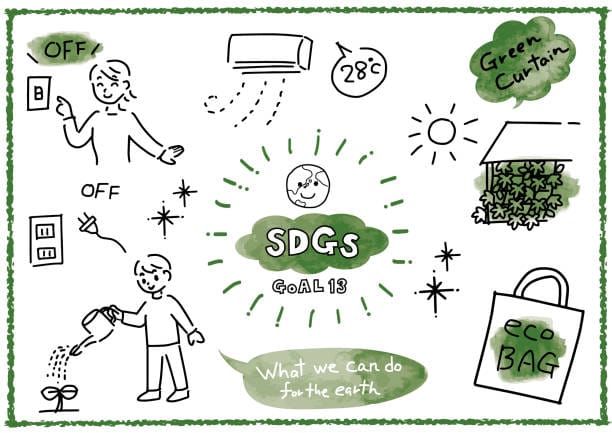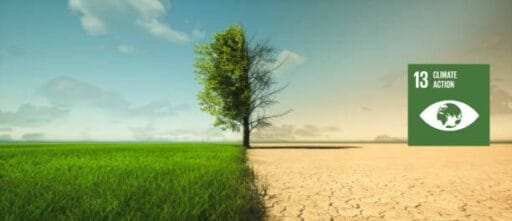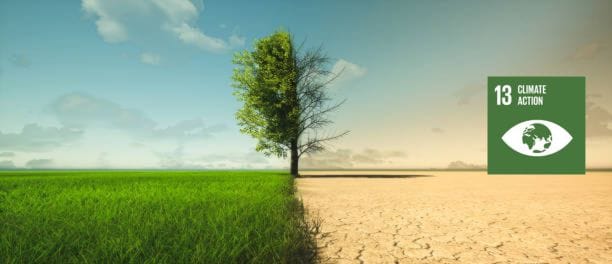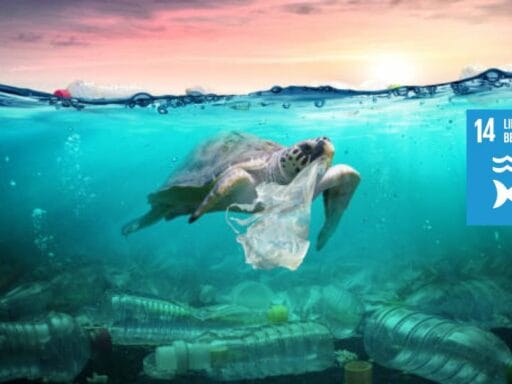Unquestionably, one of the biggest problems of our day is climate change, which has profound effects on the environment, people, and economy all around the world. The effects of climate change, which range from rising global temperatures to an increase in natural disasters like hurricanes, floods, and droughts, pose a threat to ecosystem stability and the livelihoods of billions of people. Food insecurity, displacement, and increased public health hazards are among the most severe effects experienced by vulnerable communities, especially in developing countries.
As part of the 2030 Agenda for Sustainable Development, the UN created Sustainable Development Goal 13 (SDG Goal 13) in recognition of the pressing need to address these issues. Recognizing that no nation is immune to the effects of climate change, this aim asks for swift, coordinated action to counteract these effects. SDG Goal 13 highlights the interdependence of international efforts and emphasizes that we can only reduce climate risks, prepare for unavoidable change, and ensure a sustainable future for future generations if we work together.
Understanding SDG Goal 13
SDG Goal 13 acknowledges the wider, multifaceted difficulties that climate change presents in addition to tackling its environmental effects. In order to guarantee that governments and institutions are prepared to address these concerns successfully, this goal places a high priority on integrating climate change measures into national policies, strategies, and planning. Also to help communities deal with the unavoidable effects of a changing climate, it also emphasizes the significance of promoting resilience and adaptability.
In order to achieve SDG Goal 13, education and awareness are essential. This goal seeks to increase public awareness of climate challenges so that people, organizations, and governments may take proactive measures to lower carbon footprints, embrace sustainable practices, and support climate-conscious legislation. Furthermore, SDG Goal 13 emphasizes how important it is to have both financial and technological resources to assist climate action, especially in developing nations. In order to ensure that no country or community is left behind and to close the gap between ambitious climate objectives and realistic implementation, it is imperative that these resources be mobilized.
Key Targets to Achieve Climate Action
- Strengthen Resilience and Adaptive Capacit
It is essential to strengthen communities’ resilience to climate-related risks. Creating systems and infrastructure that can withstand severe weather disasters and quickly recover is part of this.
- Integrate Climate Change Measures into Policies and Planning
Development objectives and environmental sustainability are aligned when national strategies take climate change into account. This guarantees a unified approach to mitigation and adaptation.
- Improve Education and Awareness
Increasing people’s knowledge of climate change promotes sustainable practices and well-informed decision-making on both an individual and group level.
- Implement the UN Framework Convention on Climate Change
Respecting international agreements, like the Paris Agreement, is essential to concerted international efforts to curb global warming and cut greenhouse gas emissions.
- Promote Mechanisms for Raising Capacity for Effective Climate Change-Related Planning
Encouraging small island developing states and least developed nations to pursue climate initiatives guarantees shared responsibility and equitable progress.
Challenges in Achieving SDG Goal 13
- Political and Economic Barriers
The execution of climate initiatives may be hampered by conflicting political agendas and financial interests. International collaboration and revolutionary strategies are needed to strike a balance between environmental sustainability and economic prosperity. - Lack of Resources and Funding
Financial limitations frequently prevent developing countries from investing in climate resilience and adaptation strategies. Enough money must be raised in order to make progress that is equitable. - Public Awareness and Engagement
Lack of knowledge about climate issues among the general public might result in indifference and opposition to required reforms. Promoting a sustainable culture requires extensive education and community involvement.

Case Study
Bangladesh’s Approach to Climate Resilience
Bangladesh has made great progress in increasing resilience, even though it is extremely susceptible to the effects of climate change, such as flooding and cyclones. The nation created the Bangladesh Climate Change Strategy and Action Plan (BCCSAP), emphasizing infrastructure development, disaster management, and food security. Bangladesh has increased overall resilience and decreased natural disaster fatality rates by funding cyclone shelters, early warning systems, and community-based adaptation initiatives. This proactive strategy demonstrates how including climate action into national planning can have real advantages, which is in line with SDG Goal 13.
Morocco’s Renewable Energy Revolution
Morocco’s dedication to climate resilience and renewable energy is setting the standard for achieving SDG Goal 13. Over a million homes are powered by the Noor Ouarzazate Solar Complex, one of the biggest solar farms in the world, which helps Morocco reach its 2030 target of producing 52% of its electricity from renewable sources.
Morocco’s climate policy include green infrastructure initiatives, water management, and forestry in addition to sustainable energy. These initiatives, backed by collaborations with international institutions such as the World Bank, are meant to counteract the effects of climate change, such as water scarcity and desertification. Morocco serves as a model for implementing climate action worldwide by combining innovation, sound governance, and public involvement to show how countries may address climate change while promoting sustainable growth.
FAQs
1. What is SDG Goal 13?
SDG Goal 13 is a United Nations initiative aimed at taking urgent action to combat climate change and its impacts globally.
2. Why is climate action important?
Climate action is crucial to mitigate adverse effects on ecosystems, human health, and economies, ensuring a sustainable future for all.
3. How can individuals contribute to SDG Goal 13?
Individuals can reduce their carbon footprint, support sustainable practices, and advocate for policies addressing climate change.
4. What role do governments play in achieving SDG Goal 13?
Governments are responsible for integrating climate measures into policies, mobilizing resources, and fostering international cooperation.
5. How does climate change affect developing countries?
Developing countries often face heightened vulnerability due to limited resources, making them more susceptible to climate-related hazards.
Conclusion
Reaching SDG Goal 13 requires a concerted international effort that cuts across boundaries and industries. The international community can significantly reduce the effects of climate change by taking inspiration from successful case studies like Bangladesh and tackling obstacles head-on. By working together now, we can create a resilient and sustainable future that will protect the earth for future generations.








